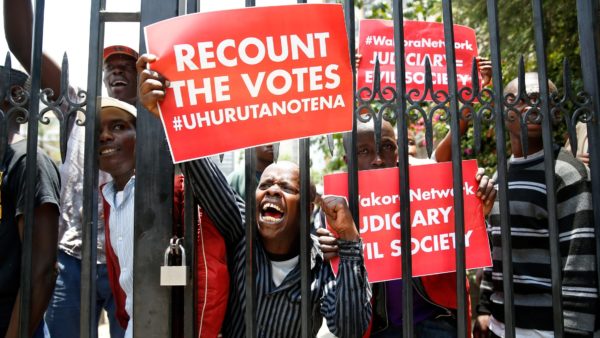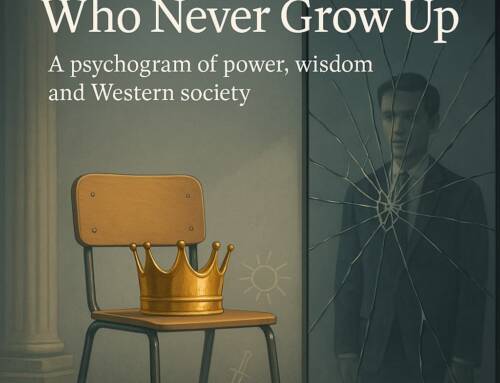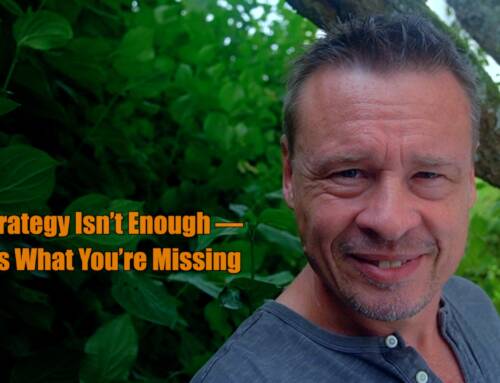What do comms strategies in development cooperation usually miss?
I regularly come across multi-year communications strategies of institutions that aim to change the global development scenario.
As a communications professional working on influencing policies and behaviour, I am interested in the role given to communications and how these concepts predetermine the communications approach drafted in the next step.
Besides that communications usually never plays any really central role—even though the success of many institutions hinges on it—I generally find two points missing from institutional strategies that substantially limit the overall effectiveness of communications approaches later on. But first a short explanatory note on:
How do institutional strategies and communications approaches fit together?
Any good communications approach works neatly towards delivering on certain identified targets of the institution’s strategy. The more concrete, the better. In that sense, a communications strategy is an elaborate second-tier component of the institution’s strategy. The two are tightly intertwined and it should be clear to the communicators involved not to go overboard with their tools.
The latter, it turns out, is something subject matter experts fear most when communicators start sketching out their ideas. The worry is not entirely unfounded. There is a tendency on in-country project level in development cooperation to save costs by hiring junior communications staff—not seldom without any track record in comms and without any guidance through experienced communicators. It’s a serious omission on the side of development organisations not to build up comms capacity properly. On the other hand, it is not conducive either when subject matter experts leverage their close ties to the organisation’s management to ensure their viewpoints on comms are ingrained in the institutional strategy.
Not to give the thematic departments all the blame, sometimes, from a comms point of view, it is not their unfortunate influence that sets the strategy process off course. It might simply be that writers critically underestimate their pre-deciding role when typing three or four paragraphs on communications. Surely, they’re usually no communications experts and they therefore consider their words an open invitation for the comms advisors to fill in a modern communications approach to their liking, not realising that for the communicators this might turn out to be a rather serious restriction.
The two critical points missing from institutional strategies
I believe that the omission of the following two points is very common with not-for-profits in development cooperation. Maybe you want to consider giving them a closer look next time you revise your organisation’s strategy.
Investment in research on creative communications
Despite all the great innovative communications tools and approaches not much of it seems to have trickled down to the foundations where the institutional strategies of not-for-profits or projects in development cooperation are assembled.
I speak of assembling comms approaches because in development cooperation they are usually compiled using a common construction kit. Why is that? – Well, beyond the limiting decisions made in the drafting of the institutional strategy, for some reason everybody in the institution needs to be able to immediately understand everything on the comms strategy. This is an extension of the saying “we are all communicators”, which implies “we all look at comms with a professional background as humans”, boiling down to communications strategies needing to be simple to be acceptable.
To make it clear, similar is not demanded of a nutrition researcher, for example, when explaining the complexity of fighting stunting even though every human is a professional eater. Everybody accepts there is a limit to breaking down scientific or professional complexity. But when it comes to communications strategy in development cooperation, communicators need to spare the complexity-reducing termini of their profession and avoid any indirect strategy, because it would take some patience on the side of the readers to familiarise themselves with some communications theory. Which is unfortunate, indirect messaging approaches, for example, often stand a good chance of penetrating where direct approaches are blunt. Ever heard of a generic approach or influencer marketing?
A reason for the ominous ‘simplicity requirement’ could be that development cooperation institutions are still very much operating with an industrial thinking mindset. Pressure on them to show for more impact largely resulted in attempts to maximise their own productivity through ‘scientific’ methods, especially by trying to raise the efficiency of their organisation and workflows. For communications plans this means first and foremost that they have to get into gear quickly and then generate a constant flow of output for visibility—as if raising productivity, by all means, was still viewed as the main avenue to achieve effectiveness. In short: No disruptions here. Sorry!
Communications, by the way, is not all about getting messages to target groups. On that line of thinking, here some words by Brian Fanzo who believes that:
“We’re moving from technology being an endpoint and online communication being about messages to technology being an amplification of experiences and online communication being about conversations.”
As I just mentioned, within the institutional strategy design, communications is typically installed as a means to support the attainment of certain institutional goals. Nothing wrong with this, it couldn’t be any other way. What’s irritating is that in development cooperation the operationalisation is often done in such a simplistic form that it severely undercuts the great opportunities communications provides you with. Let’s face it, what do comms units and consultants in development cooperation usually do? They are supposed to provide smooth launch pads for the promotion of events and reports or making sure the latest concoctions of policy (change) department are ‘delivered’ to policymakers—usually not even identifying who these individuals are or reflecting on the political economy the real policymakers have to operate in. Quite often communications is even used as a means of beautification, showing some video impressions from the event in between deadly panel discussions. Content? Not really that important. Advice on what could work more better? Too late, the concept is all set already.
Now, don’t get me wrong here. I am not on a track about demanding for communications approaches to become more interactive. Or to work on pushing out better-wrapped and better-tailored messages. Or to present the institution and its leaders more open and responsive to critique. That’s all important, but what I’m really trying to get at here is that communications should become an area in which development institutions should seriously start investing in, with the most critical part being more substantial investment in research. Research into their surroundings, the playing field of their communicative engagement, including possibilities for lobbying and much more. Why? A couple of quick points without going into detail here:
- Communications as a profession is one of the most dynamic, future-pointing business sectors of all
- Communications provides tools that can change mindsets and it has proven to frequently do so
- Communications becomes more and more professionalized in all fields, which entails high production costs for great useful communications output
- All target groups are constantly becoming more media savvy but less easily reachable via media due to increasing competition for attention
- The promotion of products, services, policies gets more competitive and will demand more financial resources. You will need research to map available funding sources as well to thoroughly substantiate the usefulness of your comms spend
- Modern big data analysis, including so-called A/B or multivariate testing, allows for scrutinising and immediately adjusting communications approaches. It takes out much of the intuitive guesswork of campaigning. Your competitors for attention will use these data research tools, so you better start looking at them soon. (If you’re not so sure what I am talking about, have a look at the brilliant book Everybody Lies: Big Data, New Data, and What the Internet Can Tell Us About Who We Really Are by former Google data analyst Seth Stephens-Davidowitz.
No tactical response capacity installed
The second aspect I usually find missing in the initial communications part of institutional strategies is a strategic core idea and a first reflection on the tactical capacity necessary to maneuver in the sharks’ pond. Why is this point missing so often?
One factor might be that common thinking within development cooperation is still, by and large, ruled by the public sector/private sector dichotomy, with the private sector usually being the other side. Even though it is rather obvious that there is no monolithic private sector. Far from it. The only thing private sector players seem to have in common is that are not public.
This observation is important for institutional strategy design because in order for any strategy to be useful it should reflect on discerning interests of different players in the game. Most notably—and this is actually nothing new—practically integrating the fact some businesses pursue economic interests that run contrary to common interests, especially those that not-for-profits in development cooperation write on their flags. As we know there are large multi-national corporations out there that use all sorts of modern communications tools, not just marketing, to heavily bombard target groups and skew the political game in their favour.
So what can be done? When PR agencies work for a client, one thing they usually do is to closely watch the communications and lobbying activity of their clients’ competitors. Having this surveillance and tactical response capacity in place is usually part of their operations.
Let me delve into this a bit more. From a strategic point of view—i.e. from the point of one wanting to have as many good nutrition policies implemented in the world as possible, for example—I think development organizations should look at the forces that work to achieve contrary goals in a much more structured way, throwing some substantial resources at it.
The classic McKinsey article Getting into your competitor’s head describes in detail what would make sense to have in your communications approach. Here is an introductory to it:
“Why does one fast-food player roll out stuff it touts as healthy, while another offers high-calorie junk? If you had been competing against either company, could you have foreseen its moves? Few can. Getting into a competitor’s head is hard because businesses and their executives are different. Yet all companies have publicly known assets, market positions, and capabilities they must protect and develop, and their top executives are often known quantities. To anticipate rather than react to their strategy, you must analyze it on two levels. On the organizational one, you have to understand the strategic fit between the competitor’s attributes and market environment. On the individual level, you need to know which of its executives makes which decision, as well as their influences and incentives.”
I think as a cross-cutting theme, development cooperation outfits that aim to influence policymaking should consider introducing strategic communications in the sense of the above. They should consider tactics not just strategy and also install a tactical facility that surveils the political economy and is capable to react to competing factors or actors, such as the pursuit of certain private companies.
Strategy vs. plan
One of my favourite subjects is the fact that in development cooperation strategies are no more than plans. For the corporate world, Peter Drucker had famously noted that in business there was a lack of strategies because managers claimed for daily pressure to leave no time to think further ahead. Until the oil price shocks of the seventies, capitalist businesses were used to produce more and more and the market just took it from them. Both aspects – lack of strategy and a skew market – look very similar to what we still see in development cooperation. Concepts are drafted by first world agencies, or indirectly through consultants who are nationals of those countries, and third world governments take what comes because they need the money endowed in it.
Everybody sees that the situation is not ideal in development cooperation, but the extent of the negative impact, I don’t believe, is fully realised by the bureaucracies involved.
“If you know the enemy and know yourself, you need not fear the result of a hundred battles.”
If we replace enemy with competing forces, we see what Wolf Lotter describes in brandeins 10/17 as a serious downside of a plan compared to a strategy: A plan defines internal workflow, is thought up for a closed system. A strategy demands not only a closer look at the market, clients and competitors but also at one’s self, your own organization and the people who make it to what it is. “Plans are exclusive, strategies are inclusive.”
For Lotter any organization has to follow its goals and not vice versa, and it is made up of human beings. Any strategy that does not consider those people who are supposed to follow it taking into account their capabilities and talents is in vain in a knowledge society. “Strategies demand identity and identities. Only that is conducive. A strategy is a sort of process to find oneself.” A workshop for strategy planning would not help here, Lotter says, since strategy planning was the attempt to go back from the real strategy to the daily routine of planning.
Some companies are not just competitors for attention
Some companies and their proxies don’t have too many qualms about their arsenal. They actively undermine what development cooperation players aim to achieve. If you don’t believe it, have a look at this article including a great three minutes video documentary by the Washington Post. Probably the ‘best’ story I have seen in a long time. It’ll show you what it’s like when you’re not aware of the marketing savviness of big food and you get hooked by them—whether you are a consumer or working in development cooperation. You need the tactical capacity to counter this activity.
New York Times: How Big Business Got Brazil Hooked on Junk Food — As growth slows in wealthy countries, Western food companies are aggressively expanding in developing nations, contributing to obesity and health problems.
International lobbyists, data firms and spin doctors are starting to shape Africa’s politics
In Africa, there’s another force coming into play which should be surveilled and included in your tactical approach: In the last decade, major PR and lobbyist firms have opened offices across Africa to offer communications for local companies and governments. Especially contracts with governments are the big bucks.








Leave A Comment